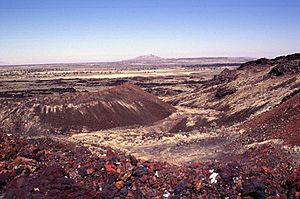Black Rock Desert volcanic field facts for kids
The Black Rock Desert volcanic field is a fascinating area in Millard County, Utah. It's not just one volcano, but a group of different volcanic features. These include well-known spots like Pahvant Butte, The Cinders, and Tabernacle Hill. The most recent volcanic activity in Utah happened right here, during an event called the Ice Springs eruption. This happened between 1140 and 1440 AD.
This volcanic field has been active for a very long time, about 2.7 million years! It's a place where the Earth's crust is always moving. Over the last 1.5 million years, this movement has created many small volcanoes. Hot lava has escaped through cracks in the ground, forming different types of volcanic cones.
Contents
What is a Volcanic Field?
A volcanic field is a region with many small volcanoes or vents. It's different from a single, large volcano. Think of it as a collection of places where lava can reach the surface.
How the Black Rock Desert Volcanic Field Formed
The Black Rock Desert area has been very active for millions of years. This activity is due to the movement of the Earth's giant plates. When these plates move, they create cracks, or "faults," in the ground.
Lava Escapes Through Faults
Through these cracks, hot, melted rock called lava can push its way up. Over time, this lava builds up to form different kinds of volcanic cones. The Black Rock Desert field has about 24 of these vents.
Different Kinds of Lava
The volcanoes here have produced two main types of lava. Some lava is thick and sticky, forming steep cones. Other lava is more runny, creating flatter, wider shapes.
Utah's Most Recent Volcanic Activity
The most recent volcanic event in Utah happened right here. It's known as the Ice Springs event. This activity took place between 1140 and 1440 AD.
The Ice Springs Event
The Ice Springs event started with an explosive eruption. This means there was a big burst of ash and rock. After the explosion, lava began to flow out. These new lava flows spread over older ones, including those from Pahvant Butte.
What it Left Behind
Today, you can still see the evidence of these powerful events. The landscape is covered with volcanic rocks and unique landforms. It's a great place to learn about Earth's geology.


